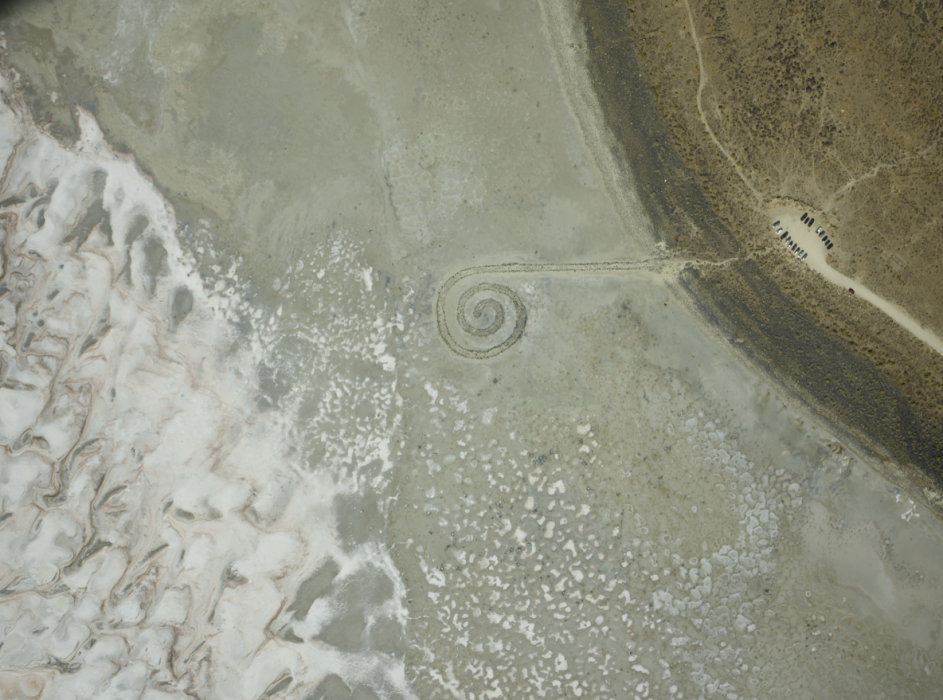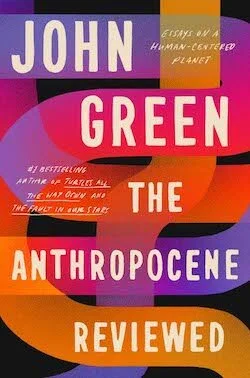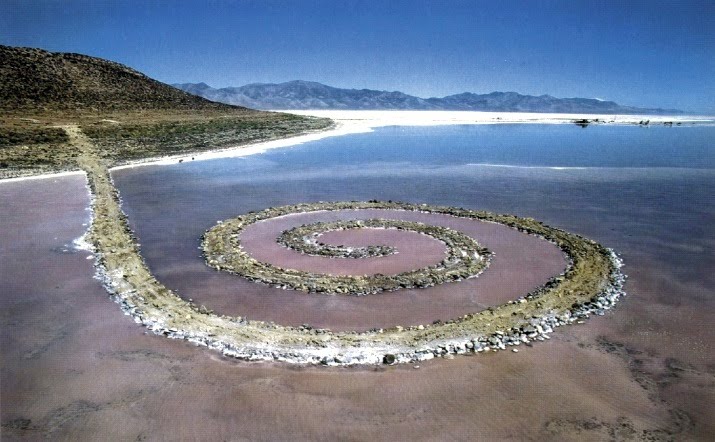Spiral Jetty is one of the important markers in the history of Land art (or Earth art, as it is also called). It was constructed by Robert Smithson in 1970 using rocks mostly from extinct volcanoes which he transported to an area in Rozel Point, Great Salt Lake, Utah. The artist unfortunately died three years after on a plane crash while surveying another location for his next earthen sculpture.
I was reminded of the Jetty after hearing Prof. Norma Respicio’s interpretation of Nena Saguil’s Untitled (Abstract). Apart from their circumvoluted form, there is a resonance in the dynamisms and fluidity of time, power, and position in both works.
The ever-changing appearance of the Jetty can be attributed to the unique collaboration of the man-made sculpture with nature and time. The transformation can be observed from the aerial photos the Dia Art Foundation took over the years.


In The Case for Land Art video, Sarah Urist Green – curator and host of The Art Assignment – argues that through these Earthworks we can contemplate man’s intricate relationship with nature and ask ourselves:
Are we part of nature or separate from it? Do we make nature or does it make us?
Spiral Jetty is an art initially shaped by man but continues to be molded at the whim of nature. There are seasons where it can be completely submerged below the lake. On the other hand, drought allows the sculpture to be fully seen. The algae and bacteria in the water can also alter the space by giving it a blood-red hue.
However, nature does not only bring beauty but destruction. Smithson was aware of the temporal quality of his work and embraced the manifestation of entropy, a concept he was highly interested in. This brought complication to the Dia Art Foundation in finding a balance to preserve the work and honor the artist’s idealism. They came to terms with it by preventing man’s interference such as taking rocks or leaving waste, and surrendering to nature’s uncontrollable interactions.
On a macro level, man’s relationship with nature has been going downhill since the Industrial Revolution took off. The current situation is expressed by environmental activist Greta Thunberg in her spoken word collaboration with The 1975 in their latest album, Notes on a Conditional Form:
We are right now in the beginning of a climate and ecological crisis
And we need to call it what it is
An emergency
As a fan of the band, I went to one of their concerts in 2019 which included this song in their setlist. I felt excited and privileged upon hearing it live because NOACF wasn’t released yet at that time.

More than surface-level appreciation, the band is aiming for something deep on The 1975 (NOACF). As the opening track, it holds an integral position to dunk listeners into the essence of the whole album. On all their albums prior to NOACF, The 1975 intros have the same melody and lyrics (go down, soft sound), but are arranged uniquely to match the overall style of the album. However, this is not the case for their latest record.
The deviation from the song’s tradition was explained by Matty Healy, the frontman:
That first track always has to be us checking in. That got us into the conversation of what is the most modern statement, or who has the most modern statement, and Greta was the decision.
Apart from working with Greta, the band and creative director Ben Ditto also commissioned artists to create visualizers as response to specific tracks in the album. One of which harkens back to Sarah Urist Green’s video where she also asked:
What kinds of structures and places and systems do we want to build?
In Rindon Johnson’s video for Don’t Worry, we see a twirling dancer in an apartment and spinning wind turbines outside. According to the artist:
I wanted to set this film in a permaculture city; one that lives harmoniously with the earth and encourages the slow stillness of being in direct dialogue with one’s natural surroundings.
Art indeed has different forms to explore man’s dynamic with his surroundings. This can also extend to manufactured sculptures such as Richard Serra’s Cycle which is large and immersive as the Jetty, though going in looks more suffocating than freeing. Both artists are within the same circle (literally and figuratively), so this parallelism is expected.
This leads me to the final fragment I conjured from Jetty: the cover of Turtles All the Way Down by John Green – writer, educator, and husband of Sarah Urist Green. The novel revolves around the protagonist’s struggles with OCD.

Months after the book tour, John recalls having a disease ironically called labyrinthitis in his podcast, The Anthropocene Reviewed.
This was also the episode where he shared that he will be releasing a non-fiction book with the same name. Just recently, the book cover was revealed.

In a vlogbrothers video, John explained the process how Grace Han came up with the design:
When I read the introduction, I was gripped by the idea of pathways and labyrinths and it stayed with me throughout the rest of the book because each essay felt like a path. […] I hope the imperfect paths and hand lettering echoes the imperfect but bold paths we all travel.
Circling back to the beginning, I posited the significance of Spiral Jetty to Land art. Su Bullard and Elizabeth Linden from University of Wollongong even push the statement further:
Smithson is a doubly meaningful marker in the search for the Anthropocene in art history then, not only because of Jetty but for his writing beyond it, art writing which braids personal narratives with outside texts, scientific propositions, and theoretical arguments.
The existence of Spiral Jetty is transitory as the life of its short-lived artist, but just like the autonomous quality of nature, it became a metaphorical land for seeds of ideas to take root and connect. It will eventually meet its total entropic erosion, but its legacy and the stories around it will carry on.
This was written for Contemporary Art (Art Stud 143) course in UP Diliman, 2nd Semester AY 20-21.
Works Cited
“Artists Respond To NOACF.” Youtube, uploaded by The 1975, 4 Dec. 2020, youtube.com/playlist?list=PLjhJRPvOzuIpKk1KeJ-x0O-Vuh6SitqQg.
Ballard, Su and Elizabeth Linden. “Spiral Jetty, geoaesthetics, and art: Writing the Anthropocene.” The Anthropocene Review, vol. 6, no. 1-2, 2019, pp. 142-161, dx.doi.org/10.1177/2053019619839443. Accessed 21 Mar. 2021.
Gorgoni, Gianfranco. “Robert Smithson showing a drawing to Richard Serra, Spiral Jetty, Great Salt Lake, Utah.” 1970. Utah, United States. The J. Paul Getty Museum, www.getty.edu/art/collection/objects/130387/gianfranco-gorgoni-robert-smithson-showing-a-drawing-to-richard-serra-spiral-jetty-great-salt-lake-utah-italian-1970. Accessed 21 Mar. 2021.
Green, John. “How a Book Cover Gets Designed.” Youtube, uploaded by vlogbrothers, 17 Mar. 2021, www.youtube.com/watch?v=ZrJILA-1Wrc.
Green, John. “The Anthropocene Reviewed.” John Green, www.johngreenbooks.com/the-anthropocene-reviewed-book. Accessed 21 Mar. 2021.
Green, John. “The Anthropocene Reviewed, Reviewed.” WNYC Studios, www.wnycstudios.org/podcasts/anthropocene-reviewed/episodes/anthropocene-reviewed-john-green. Accessed 21 Mar. 2021.
Green, John. “The Anthropocene Reviewed, Reviewed.” Spotify, WNYC Studios, 2020, open.spotify.com/episode/20Dg3AgYRcYp9O2hceDMyd. Accessed 21 Mar. 2021.
Green, John. “Turtles All the Way Down.” John Green, www.johngreenbooks.com/turtles-all-the-way-down-book. Accessed 21 Mar. 2021.
Green, Sarah Urist. “The Case for Land Art | The Art Assignment | PBS Digital Studios.” Youtube, uploaded by The Art Assignment, 16 June 2017, www.youtube.com/watch?v=STW0eZDsKVg.
Healy, Matthew. “The 1975 (NOACF) – What have the artists said about the song?” Genius, genius.com/The-1975-the-1975-noacf-lyrics. Accessed 21 Mar. 2021.
Respicio, Norma A. “BRIDGING THE GAP | Norma Respicio on Nena Saguil’s Untitled (Abstract) | UP Diliman DAS & KLFI.” Youtube, uploaded by Kalaw-Ledesma Foundation Inc., 19 Feb. 2021, www.youtube.com/watch?v=68t6X1aMpU0.
Serra, Richard. Cycle. 2011. Gagosian. Artsy, www.artsy.net/artwork/richard-serra-cycle. Accessed 21 Mar. 2021.
Shapiro, Gary. “Spiral Jetty.” Holt/Smithson Foundation, Nov. 2019, holtsmithsonfoundation.org/spiral-jetty-0. Accessed 21 Mar. 2021.
Smithson, Robert. Spiral Jetty. 1970. Great Salk Lake, Utah. Khan Academy, www.khanacademy.org/humanities/art-1010/post-war-american-art/minimalism-and-earthworks/a/smithsons-spiral-jetty. Accessed 21 Mar. 2021.
Smithson, Robert. Spiral Jetty Aerial Documentation. 1970. Great Salk Lake, Utah. Dia Art Foundation, www.diaart.org/collection/spiraljettyaerials. Accessed 21 Mar. 2021.
“The 1975 – Rindon Johnson responds to ‘Don’t Worry’.” Youtube, uploaded by The 1975, 8 July 2020, www.youtube.com/watch?v=RjxR5_rLFQo.
“The 1975 – The 1975.” Youtube, uploaded by The 1975, 28 May 2020, www.youtube.com/watch?v=4fwEG8XK1uU.

Leave a Reply